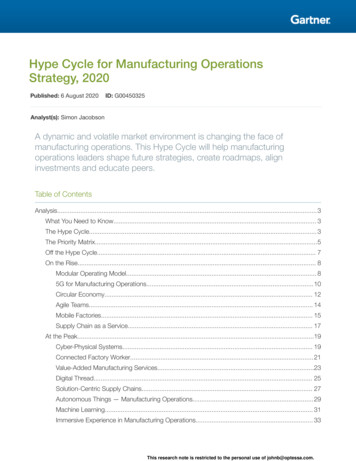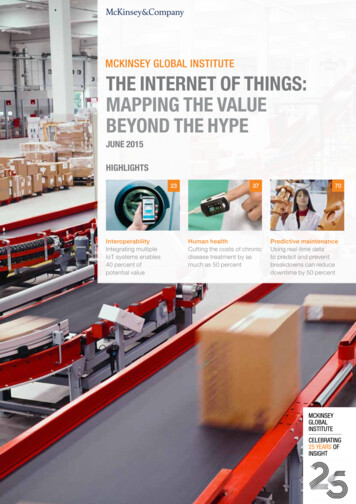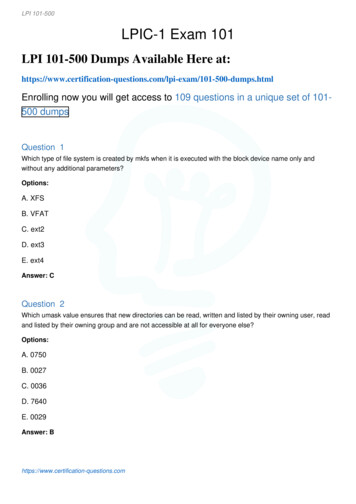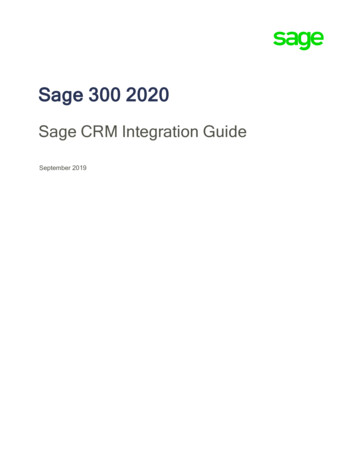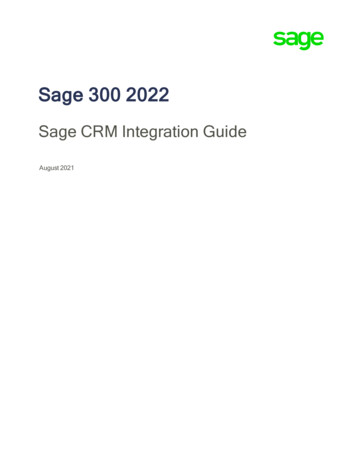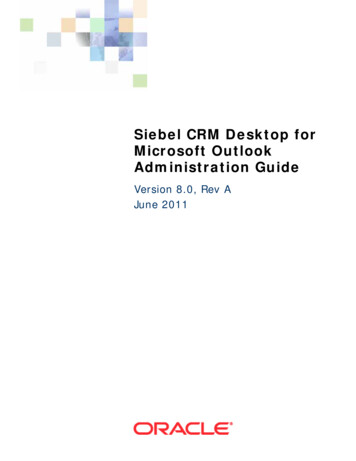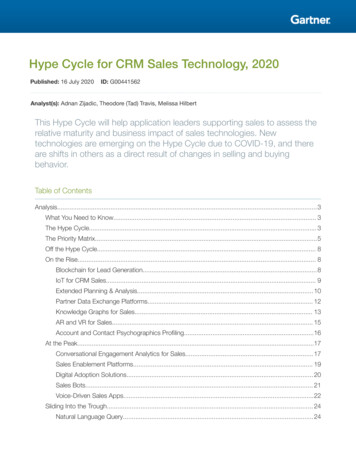
Transcription
Hype Cycle for CRM Sales Technology, 2020Published: 16 July 2020ID: G00441562Analyst(s): Adnan Zijadic, Theodore (Tad) Travis, Melissa HilbertThis Hype Cycle will help application leaders supporting sales to assess therelative maturity and business impact of sales technologies. Newtechnologies are emerging on the Hype Cycle due to COVID-19, and thereare shifts in others as a direct result of changes in selling and buyingbehavior.Table of ContentsAnalysis. 3What You Need to Know. 3The Hype Cycle. 3The Priority Matrix.5Off the Hype Cycle. 8On the Rise. 8Blockchain for Lead Generation.8IoT for CRM Sales. 9Extended Planning & Analysis. 10Partner Data Exchange Platforms. 12Knowledge Graphs for Sales. 13AR and VR for Sales. 15Account and Contact Psychographics Profiling.16At the Peak.17Conversational Engagement Analytics for Sales.17Sales Enablement Platforms. 19Digital Adoption Solutions. 20Sales Bots. 21Voice-Driven Sales Apps.22Sliding Into the Trough. 24Natural Language Query. 24
Embedded Analytics.26Relationship Intelligence.27Customer Success Management.28Quota Planning and Optimization.30Strategic Account Management.31Account-Based Marketing Platforms. 33Sales Training and Coaching Solutions. 35Robotic Process Automation (RPA).36Sales Acceleration. 38Mobile Sales Productivity. 39Climbing the Slope. 40Sales Predictive Analytics. 40Sales Performance Management. 42Visual Configuration. 43Entering the Plateau. 45Recurring Revenue Management.45Partner Relationship Management. 45Price Optimization and Management for B2B. 47Territory Planning and Optimization. 48Data Intelligence Solutions for Sales. 49Appendixes. 51Hype Cycle Phases, Benefit Ratings and Maturity Levels. 52Gartner Recommended Reading. 53List of TablesTable 1. Hype Cycle Phases. 52Table 2. Benefit Ratings. 52Table 3. Maturity Levels. 53List of FiguresFigure 1. Hype Cycle for CRM Sales Technology, 2020.5Figure 2. Priority Matrix for CRM Sales Technology, 2020. 7Figure 3. Hype Cycle for CRM Sales Technology, 2019.51Page 2 of 54Gartner, Inc. G00441562
AnalysisWhat You Need to KnowApplication leaders supporting sales technology will find an increased number of innovativesolutions in this year’s Hype Cycle for CRM Sales. Technologies that help digital sales optimizationefforts have moved closer toward mainstream adoption and with increasing maturity. Meanwhile,those technologies that have become a staple within sales organizations have moved off this year’sHype Cycle due to their market position as mainstream platforms.Additionally, the COVID-19 pandemic will accelerate the pace of adoption of sales technologies thatcan help improve digital engagement efforts with buyers. Sales organizations will continueoptimizing sales processes to provide timelier and more powerful prospect and customer insightsdriven by data. The pandemic has increased engagement with sellers via virtual channels versusthat of face-to-face interactions. Sales organizations can no longer expect the extended face timeafforded to their reps in on-site meetings and must reevaluate technological investments to preparefor a strategic shift in how they will sell in the near term and long term. Gartner expects that sellerswill increasingly turn to multiexperience, digital solutions to replace their typical face-to-faceinteractions. This will include digital sales rooms — a capability currently provided in a limitedmanner by digital content management solutions for sales and sales enablement vendors.Application leaders supporting sales should review all of the innovations profiled in this Hype Cycleto understand the costs, risks and benefits of each. Prioritize those with high impact and fasterspeed to mainstream adoption. Evaluate the more risky/emerging technologies on the left side ofthe curve, if seeking an opportunity for competitive differentiation. Evaluate the more matureinnovations post-peak on the right side of the curve, which are more mainstream because there is acompetitive disadvantage if they are not already being used. Due to the global pandemic, evaluatetechnologies that will enable sales organizations to recover more quickly and adapt the sellingmodel to new buyer-seller dynamics.The Hype CycleThis Hype Cycle will help application leaders supporting CRM sales technology to assess therelative maturity and business impact of various innovations. Key investment drivers of thetechnologies featured in this Hype Cycle include: increasing sales optimization efforts viadigitalization, process automation, deeper insights from conversational engagement analytics, salespredictive analytics, and the increasing need to realize existing sales technology investmentsthrough the use of digital adoption solutions.New entrants to this year’s Hype Cycle: Augmented reality (AR) and virtual reality (VR) for sales. AR and VR solutions have increasedin prominence as a result of COVID-19 as sales organizations find themselves working remotely.Selling organizations that are heavily reliant on on-site demonstrations with heavy equipment ortradeshow experiences (such as those seen in manufacturing, life sciences and tradeshowexperience, along with B2C) have found that these technologies address some of theirGartner, Inc. G00441562Page 3 of 54
shortcomings. While AR and VR differ in terms of technology and use cases, these solutions areexpected to increase in proliferation postpandemic, as sales organizations transform existingbusiness processes given current global circumstances. Most AR and VR solutions are notenterprise-ready to support large volumes of users, nor content-specific to sales processes.However, Gartner expects an influx of vendors to address these capabilities and gaps. Robotic process automation (RPA). RPA allows the ability to build scripts to integrate anyapplication via the user interface (UI) and a dashboard orchestrator that automates routine,repetitive, rule-based, predictable tasks such as writing back sales force automation (SFA)records into the SFA system. There is a level of automation already inherent in some existingsales technologies, but RPA holds the promise of automating more extensive processworkflows. Workflows such as those seen in sales order and invoice processing, dataaggregation and management; commonly seen when account or contact information resides inmany different systems (sales and nonsales); and lead nurturing scenarios. Account and contact psychographics profiling. This innovation brings with it the ability tofurther enable sales organizations to personalize outreach efforts, based on the communicationstyle or personality traits of an individual, determined by assessments using psychographicmethodologies seen in DiSC (dominance, influence, steadiness and conscientiousness) orMyers-Briggs theories. At the account level, Gartner’s enterprise technology adoptionmethodology enables technology vendors to ascertain behaviors and tendencies of companiesbeing targeted. This market is sure to become increasingly important post-COVID-19 as salesorganizations continue to work virtually, and as the need for differentiation and personalizationincreases. The focus will be to include a more proactive and personalized outreach effort thanpreviously would have been possible, especially as sales organizations fight for client attentionand time, which has become increasingly difficult to do virtually.We see rapid movement along the Hype Cycle for technologies like sales predictive analytics,recurring revenue management, conversational engagement analytics for sales, AR and VR forsales, and mobile sales productivity. Also progressing quickly are newer technologies like sales bots(formerly called virtual digital sales assistants).Several technologies have reached the Plateau of Productivity but remain at the edge of the HypeCycle. They include data intelligence solutions for sales, which are now more pervasive withinorganizations, seen in the increased use of tools offered by such names as LinkedIn (SalesNavigator), ZoomInfo, and Dun & Bradstreet. Moreover, due to the pandemic, this market hasincreased in interest with Gartner clients and sales organizations needing to fill the funnel with leadsor prospects and enrich current data gaps while their employees work from home. Integratedplanning has been absorbed by a wider market and thus renamed to extended planning andanalysis; and as such is reflected in the early stages of the Innovation Trigger of the Hype Cycle.Maturing technologies. Technologies such as territory planning and optimization, priceoptimization and management for B2B, and partner relationship management have moved closer tothe Plateau of Productivity. Sales organizations will still find them to be valuable investments,particularly helpful in current pandemic scenarios, or in wider optimization efforts in general.Technologies that have just entered the Plateau of Productivity are still innovative and will provide acompetitive differentiator for several more years. Application leaders should use these technologiesPage 4 of 54Gartner, Inc. G00441562
to gain a competitive advantage by applying various combinations of data-driven insights fromemerging and mature technologies. The focus should be on those containing natural languageprocessing (NLP) and machine learning (ML) techniques such as those seen in conversationalengagement analytics, predictive sales analytics, and sales acceleration solutions.Figure 1. Hype Cycle for CRM Sales Technology, 2020The Priority MatrixGartner sees two trends currently driving many of the innovative sales technologies at differinglevels of maturity. The first trend in particular is a continuation from last year:1.Digital optimization of sales continues to be the source of innovation in sales technologies, aswas the case last year. Digital optimization as an innovation factor has continued for several keyreasons: There has been a shift to B2B digital commerce solutions to augment sales processes,especially in post-COVID-19 endeavors, where organizations have struggled to find revenuestreams due to imposed lockdowns. B2B digital commerce consists of multipleGartner, Inc. G00441562Page 5 of 54
technologies, as seen in the “Hype Cycle for Digital Commerce, 2020.” Innovation profilessuch as digital commerce software as a service (SaaS), virtual customer assistants, andpersonalization engines are a few of the emerging and mature technological componentsthat will enable this shift to B2B digital commerce. Prospects and customers alike are continuing to seek multiple sources of information viaonline searches, peer review sites and content from independent third parties, for example,demonstrating channel-agnostic behavior when it comes to seeking out information for aspecific project. This means that tools like data intelligence solutions for sales and RPA canhelp capture pertinent information channels, where sellers are not present, and surfacethese insights inside an SFA solution. Sales analytics initiatives are still a major source of interest as many sales organizationshave struggled to confidently rely on their forecasting accuracy, now even more so duringthe COVID-19 pandemic. Therefore, tools like sales predictive analytics have seenincreasing levels of interest and usage, Gartner inquiries have confirmed. Gartner has seen a shift in sales enablement platforms to include more buyer engagementanalytics. The overlap to sales acceleration will likely increase and be absorbed into salesenablement. Sales acceleration platforms are powered by data-driven insights such asconversational and sentiment analysis. We expect that to soon include contactpsychographics and emotion analysis needed for virtual meetings. As the pandemiccontinues to linger, there is the potential for tools like AR and VR to make an increasingsales play when closing the deal in selling complex equipment, or to fill the need for on-sitedemonstrations. Remote work and pandemic disruption. Gartner has fielded anincreasing amount of inquiries, especially in 2Q20, about the need to move sales processesfrom analog to digital because of circumstances surrounding nontravel and work-fromhome orders. COVID-19 has transformed the way sales organizations are investing in newtechnologies and, at the same time, reducing or retiring ones that are analog. It has furtherintensified the need for digital optimization and paved the way for transformative efforts. Forexample, virtual high-touch sales are potentially being enabled by innovative solutions suchas conversational engagement analytics, as well as AR and VR for sales. Prior to thepandemic, inquiries surrounding such solutions were nonexistent within sales. Thesesolutions have risen out of a necessity to facilitate a semblance of face-to-faceengagement, where product demonstrations could, for example, entail complex software orequipment.Page 6 of 54Gartner, Inc. G00441562
Figure 2. Priority Matrix for CRM Sales Technology, 2020Gartner, Inc. G00441562Page 7 of 54
Off the Hype CycleFive technologies from last year’s Hype Cycle — sales contract management, CPQ applicationsuites, digital content management for sales, lead management, and sales KPI analytics — are nolonger on the Hype Cycle due to reaching the Plateau of Productivity and maturity. In 2019, many ofthe technologies were at the preplateau level or had already reached the plateau and thus were ontheir way off the Hype Cycle. This means that a large majority of sales organizations haveembedded the technologies as part of their core sales tech stack, or that the technologies arepervasive within sales organizations.On the RiseBlockchain for Lead GenerationAnalysis By: Adnan ZijadicDefinition: Blockchain for lead generation delivers the ability to source leads and share informationusing a decentralized platform in a peer-to-peer network. It offers the ability to provide users withthe most current leads via the exchange of firmographic information based on crowdsourcing datacollection methods while monetizing and controlling data sharing and protecting privacy. Leads canbe sourced via a freemium model or via tokens on the blockchain exchange to the highest bidderusing smart contract processes and automation.Position and Adoption Speed Justification: Blockchain for lead generation has just hit theInnovation Trigger, with limited use cases and very few production implementations across the SMBor enterprise landscape. It will take time for organizations to take notice due to its embryonic stage;however, the technology offers a potential alternative to typical lead and contact generationmethods, such as via data intelligence solutions (DIS) or any other third-party databases.Blockchain for lead generation offers a single version of the truth, supported by immutable data andaudit trails, and no single entity is in control. This leads to a transparent and trustworthy biddingprocess for information and/or leads that can be bought with tokens. Blockchain for lead generationfaces many obstacles inherent in blockchain technology in that blockchain for lead generation is stillimmature and does not yet interoperate using mainstream blockchain technology standards. Inaddition, financial services are leading the planning and experimentation activity for this blockchaintechnology outside of lead generation, while other sectors such as transportation, telecom,government, and utilities are increasingly becoming engaged. The obstacles to adoption can beovercome once use cases have been proven.User Advice: Sales technology leaders will not find many vendors currently offering blockchain forlead generation. Still, organizations can learn more about its potential use cases in their particularcontext while preparing for the proliferation in the vendor landscape. It is also a good opportunity toexperiment with blockchain as a service, offered by some CRM vendors and their ecosystem ofpartners. Blockchain for lead generation offers the potential to optimize costs incurred on procuringdata from third parties by eliminating a central authority, such as data intelligence solutions whereinthe data contained is sometimes stale and unreliable, while also monetizing data shared acrossPage 8 of 54Gartner, Inc. G00441562
blockchain ledgers and networks in a peer-to-peer network, offering an additional revenue streamand giving users back the control of their data and identities.Business Impact: Blockchain for lead generation can have a transformational impact on thebusiness and how sales organizations have typically sourced leads and contact information. Ratherthan source from many unreliable third-party databases, users can instead partake in a networksharing mechanism to source leads and contacts that may fit a particular organization, whilepassing on leads that do not conform to the ideal customer profile, and in the process monetizingthe sharing of information among constituents participating in the blockchain network. In addition,this will open opportunities to lower costs allocated to DIS and master data management solutionsby removing the “middle man” while also addressing data residency concerns due to theimmutability of blockchain technology, particularly for companies that have to maintain GDPRcompliance in their sales CRM systems. Blockchain allows untrusted parties to work together and inreal time to know if a lead is going to a competitor, which saves time and money pursuing a lostlead, while providing contextual insights.Benefit Rating: TransformationalMarket Penetration: Less than 1% of target audienceMaturity: EmbryonicSample Vendors: Datafund; LeadCoinIoT for CRM SalesAnalysis By: Theodore TravisDefinition: The Internet of Things comprises an ecosystem that includes things, communications,applications and data analysis. Its uses range from transforming business operations to newrevenue generation. In sales processes, the IoT includes technology that performs buying functionson behalf of customers, such as ordering technology embedded in consumer devices and B2Bapplications, or sales agents that perform actions on behalf of sellers.Position and Adoption Speed Justification: The market for both B2B and B2C sales is stillembryonic. Internet of Things (IoT) architectures are still emerging; different applications and stylesinclude the use of single instantiations of physical devices or multiples of such instantiations (selfdriving cars). Moreover, Gartner finds that many organizations are still at the planning stage, workingon higher-level considerations such as their digital transformation strategy. This means that IoT forsales is still many years away from reaching maturity.User Advice: The earliest forms of IoT for sales are B2B- and asset- (physical product) centric. It isoften linked with processes that are close to customer service, such as customer successprograms, product upgrades, spare parts sales, consumables, the increase of capacity (e.g.,additional storage, solar panels or batteries) and service sales. In this manner, IoT sales interactionswill become a new sales channel that application leaders should start to evaluate and support,particularly those working in consumer and manufacturing verticals.Gartner, Inc. G00441562Page 9 of 54
Application leaders supporting sales should: Be aware that IoT-based selling, as currently adopted, is still an innovative pace layerapplication. This means that during the next five years you will need to consider customdevelopment to connect devices with your back-office systems and processes. Assess the ability of the IoT architecture to integrate with CRM and marketing applications inorder to support consistent messaging with prospects and customers. Train existing sales or selling partners on how IoT will enhance their ability to sell to consumers,but only if direct human interaction remains a requirement.Business Impact: Experimental IoT selling has the potential to become a major disruptor to bothB2C and B2B sales. It is possible that IoT for sales will develop different selling styles. And that ahuman or agent “handler” will assign responsibility to initiate and conduct the automated salesdialogue to individual sales engines, based on their predictions, with the ability to detect the needfor shifts within a sales process.Benefit Rating: TransformationalMarket Penetration: Less than 1% of target audienceMaturity: EmbryonicSample Vendors: Amazon web Services; Google; Microsoft Azure IoT Edge; Oracle; Pegasystems;ZohoRecommended Reading:“Market Definitions and Methodology: Internet of Things Forecast”“Explore the Internet of Things’ Potential for CRM”Extended Planning & AnalysisAnalysis By: John Van Decker; Melissa Hilbert; Robert AndersonDefinition: In the market, financial planning and analysis solutions have been augmented with usecases that leverage their core “rate X volume” capability into other disciplines beyond the financedepartment, such as in sales and operations planning, human resources planning, and IT planning.This extension into these new areas is referred to as XP&A and provides a more complete integratedenterprise planning footprint beyond what integrated financial planning (prior Hype Cycle entry)attempted to fulfill.Position and Adoption Speed Justification: NOTE: This replace the Integrated Financial PlanningHype Cycle entry from 2019. It has evolved to become a component of eXtended Planning andAnalysis (XP&A).Page 10 of 54Gartner, Inc. G00441562
Many organizations strive to have an integrated enterprise planning environment, however, mosthave evolved to having more than five to 10 different planning solutions in their enterprise, as amultipurpose planning solution has only recently become available. This is a result of the variousdepartments being able to pursue their own planning solutions independently, often without acommon theme and consistency of purpose. While many of these tools have specific functionalityaddressing much needed requirements in specific disciplines (e.g., sales force compensation), theseXP&A solutions are increasingly stepping up to the challenge by incorporating more of these nichefunctionalities into their use cases.When an organization chooses an XP&A approach, they are able to leverage the same compositearchitecture platform for multiple use cases. They can concentrate usage and economies of scale toleverage a trained IT staff across multiple areas. It can also provide opportunities to betterintegration of operational planning areas with finance as well as other operational areas. The initialbase of XP&A platforms has evolved by improving performance, collaboration, workflowmanagement, analytics, governance and ease of use.XP&A is being implemented by many business process consultancies in client organizations asmore new ERP projects are being extended by ERP-based XP&A tools. The solutions will continueto develop, however, some are not as robust as a best-of-breed counterpart. As a result, businessculture and data integration pose significant challenges to adoption of integrated planning. Basedon these factors, we expect integrated planning to reach the Plateau of Productivity in five to 10years.User Advice: Initially, organizations need to take an accurate inventory of planning solutions,including specific business applications, Excel-based processes and planning done offline todetermine where there could be consolidation opportunities.Monitor the progress of XP&A vendor roadmaps and determine where functional gaps may existversus specific best-of-breed applications. Determine if and when it would be possible toconsolidate some of these one-off planning tools into a more common XP&A approach.Develop an ideal vision for integrated enterprise planning (IEP) for your organization, includingconnections between operational and financial planning processes. Build a business case basedupon the ability to better integrate planning into a more consistent platform.Business Impact: XP&A can be leveraged to consolidate as well as provide a formal consistentapplication approach to the enterprise planning process. By consolidating these into a companyplatform, organizations can achieve economies of scale that leveraged new compositearchitectures, and can be a value tool to link operational and financial planning. This can alsoprovide innovation in codifying new planning models and enable organizations to reforecast intoday’s changing economy at a more rapid pace. It enables organizations to have bettercollaboration and provide the ability to bring often disconnected planning into a commonenvironment.XP&A is an approach to consolidate enterprise planning solutions, however, it will not be a goodsubstitute for all planning processes (e.g., multienterprise planning, integrated business planning) asGartner, Inc. G00441562P
Gartner has seen a shift in sales enablement platforms to include more buyer engagement analytics. The overlap to sales acceleration will likely increase and be absorbed into sales enablement. Sales acceleration platforms are powered by data-driven insights such as conversational and sentiment analysis. We expect that to soon include contact

